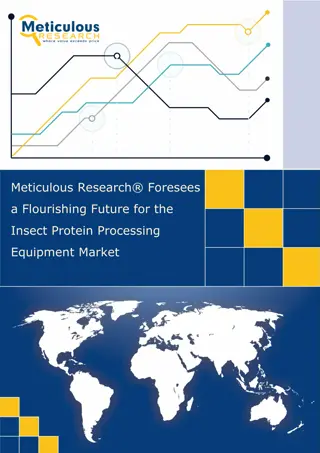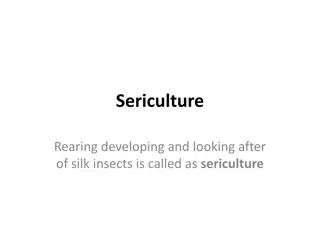Insect Abdominal Structures and Appendages: An Overview
The abdomen of insects plays crucial roles in respiration, reproduction, digestion, excretion, and metabolism. The number of abdominal segments varies across species, with reductions and modifications seen in different insect groups. From the propodeum to pregential and postgenital segments, each pa
3 views • 6 slides
Sustainable Rice Production in Pakistan: Challenges and Strategies
Pakistan's economy heavily relies on rice exports, with the country being a significant producer and exporter. However, challenges such as pesticide residues, major insect pests, and diseases threaten rice production. Key parameters for production include cultivation of improved varieties, pest mana
2 views • 42 slides
Read and delete this slide
The Pharmacy First service in England, scheduled to start on January 31, 2024, will replace the Community Pharmacist Consultation Service (CPCS) and offer seven new clinical pathways. It includes consultations, urgent medication supply, and referrals for minor illnesses like sinusitis, sore throat,
0 views • 30 slides
Precision Fermentation in Sustainable Food Production
Precision Fermentation is a specialized bioprocessing technique that utilizes microbes as cell factories to produce specific functional ingredients like proteins, vitamins, enzymes, and more. This innovative technology addresses the challenges of increasing food demands in a sustainable way, offerin
2 views • 12 slides
Insect Identification for FFA Agronomy Skills Contest
Explore a variety of insects including the Alfalfa Weevil, Aphid, Army Worm, Assassin Bug, Bean Leaf Beetle, Black Cutworm, Chinch Bug, Colorado Potato Beetle, Common Stalk Borer, Corn Earworm, Corn Rootworm, Cricket, Cucumber Beetle, European Corn Borer, Flea Beetle, Grasshopper, Green Lacewing, Gr
1 views • 37 slides
Teen Basic First Aid Tips by Ashlee Meardith Trumbull County 4-H Educator
Learn basic first aid tips for teens provided by Ashlee Meardith Trumbull County 4-H Educator. The tips cover handling bug/insect bites, animal bites, poisoning incidents, burns, cuts, and scrapes. Each section includes common symptoms and appropriate first aid measures to take in case of emergencie
4 views • 11 slides
Navigating the New Horizons: Rediscovering the Insect Protein Market Dynamics
According to BIS Research, the Global Insect Protein Market was estimated to be at $342.87 million in 2021, which is expected to grow with a CAGR of 26.49% and reach $1,386.55 million by 2027.
2 views • 2 slides
Insect Fertilizers Market Worth $319.7 Million by 2029
The fertilizers industry in Southeast Asia faced numerous challenges due to the COVID-19 pandemic, impacting the fertilizer distribution within and across markets in the Asia-Pacific region. Although lockdowns were imposed in Malaysia, fertilizer production facilities were given clearance to continu
5 views • 3 slides
Protein Expression Market
Protein Expression Market by System (Mammalian [CHO, HEK 293], Non-mammalian [Bacterial, Insect, Yeast]), Offering (Kits & Reagents, Vectors, Competent Cells, Services), Application (Industrial, Therapeutic, Research), and End User - Global Forecast to 2030\n\n
4 views • 4 slides
Insect Protein Processing Equipment Market Worth $210.6 Million by 2029
The insect protein processing equipment market is driven by innovations in insect protein processing equipment, the increasing focus of insect protein manufacturers to reduce production costs, increased investments in the insect-based protein industry, and the rising demand for insect protein in the
0 views • 3 slides
Natural Resources and Resource Economics
Economics of natural resources focuses on the supply, demand, and sustainable allocation of the Earth's resources. It aims to develop a sustainable economy that protects natural resources for future generations. Natural resources are essential for human survival and include biotic and abiotic resour
1 views • 11 slides
The Discovery and Impact of DDT on Insect Control
Paul Miller's 1939 discovery of DDT as an effective insecticide led to its Nobel Prize recognition in 1948. DDT's preparation, physical properties, insecticidal effects, and environmental concerns are discussed, highlighting its widespread use in developing nations despite bans in advanced countries
0 views • 28 slides
The Fascinating World of Sericulture: Rearing and Harvesting Silk Insects
Sericulture, the art of rearing and nurturing silk insects, has been practiced since ancient times, yielding the exquisite natural fiber known as silk. This fine material has captivated humans for its beauty and versatility. The process involves skill and scientific knowledge, with various types of
0 views • 16 slides
Non-Insect Pests in Agriculture
In this lecture, we delve into important non-insect pests affecting agriculture, such as nematodes, mites, snails, slugs, crabs, millipedes, birds, rodents, and more. Learn about their systematic positions, damages they cause, and characteristics. Explore the world of millipedes and centipedes, thei
0 views • 15 slides
Insect Repellent Market: Strategies for Success in a Competitive Market
The Global Insect Repellent Market size is expected to be worth around USD 26 Billion by 2033, from USD 5 Billion in 2023, growing at a CAGR of 6.9% during the forecast period from 2023 to 2033.\n\nClick here for requesting a sample : \/\/market.us\/
1 views • 3 slides
Boreal Wildfire Effects and Research Synthesis
The thematic breakout report focuses on the impacts of fire and insect disturbances on the environment, with projects studying wildfires in boreal regions and their effects on ecosystems. Various studies funded by agencies like NASA and ERC aim to understand wildfire vulnerability, resiliency, and c
0 views • 10 slides
Insect Pests of Citrus: Identification, Behavior, and Management
Insect pests such as citrus butterfly, fruit-sucking moth, leaf miner, rust mite, and bark-eating caterpillar pose significant threats to citrus plants. These pests can damage citrus seedlings and various fruit varieties. Understanding their appearance, distribution, life cycle, and management techn
4 views • 14 slides
The Fascinating World of Insect Antennae
Insect antennae, also known as feelers, play a crucial role in sensory perception for insects. They help in detecting chemicals, perceiving various stimuli, and even aid in specialized functions like communication and prey-catching. The structure of antennae varies across insect species, showcasing
0 views • 11 slides
Insect Circulatory System: Overview and Functions
The insect circulatory system comprises an open type, where blood flows through the body cavity. Divided into three sinuses, it houses vital organs such as the heart and nerve cord. The dorsal vessel acts as the main organ of circulation, along with accessory pulsatile organs that supply blood to ap
0 views • 19 slides
Insect Legs: Anatomy and Adaptations
Explore the intricate anatomy of insect legs, comprising segments like coxa, trochanter, femur, tibia, and tarsus, each serving specific functions for locomotion. Discover how these legs are adapted for diverse tasks like walking and running in different insect species.
0 views • 18 slides
Utilizing Sterile Insect Technique for Aedes Aegypti Control
The Sterile Insect Technique (SIT) is a biologically-based method used to manage key insect pests by releasing sterile insects to decrease population reproduction. This technique, developed through genetic manipulation and ionizing radiation, has been instrumental in controlling insect populations l
0 views • 13 slides
Insect Farming Market
The global Insect Farming Market size is expected to be worth around USD 2 billion by 2033, from USD 1.5 billion in 2023, growing at a CAGR of 4.3% during the forecast period from 2023 to 2033.\nClick here for request a sample: \/\/market.us\/report\
1 views • 4 slides
Global Insect Pest Control
The Global Insect Pest Control Market is anticipated to reach USD 20.43 billion by 2032, at a CAGR of 4.6% over the predicted period from 2022 to 2032.
1 views • 4 slides
The Key Articles of the Nagoya Protocol on Access to Genetic Resources and Benefit-Sharing
The Nagoya Protocol aims to promote fair sharing of benefits from genetic resources utilization for conservation efforts. It encompasses access, technology transfer, funding, and respect for rights over resources and technologies. The protocol applies to genetic resources, traditional knowledge, and
2 views • 19 slides
Natural Resources: Types and Conservation
Natural resources play a crucial role in sustaining life on Earth, encompassing elements like water, air, soil, minerals, and more. These resources can be classified into renewable and non-renewable categories, with the former being replenishable through natural cycles and the latter being finite an
0 views • 24 slides
The Insect Gas Exchange System
The insect gas exchange system involves spiracles, tracheae, and tracheoles that facilitate the exchange of gases to support respiration in insects. Spiracles lined with chitin control airflow, while tracheae and tracheoles enable oxygen to dissolve into the haemolymph through passive diffusion, sup
0 views • 18 slides
The Biochemistry of Insect Hemolymph
Insect hemolymph, also known as blood, plays a crucial role in maintaining the tissues throughout the body. It consists of plasma containing hemocytes suspended in a fluid rich in various chemicals. The pH of the hemolymph ranges between 6.4 and 6.8, with variations in volume across different insect
0 views • 9 slides
Embracing Insect-Based Diets for a Sustainable Future
Emphasizing the urgency of meeting the growing protein demand sustainably, the article explores the benefits of entomophagy - consuming insects as food. Experts advocate for insect-based diets to address environmental concerns, citing insects as a rich protein source with lower greenhouse gas emissi
0 views • 6 slides
Economic Entomology: A Focus on Pest Management in Horticultural Plants
Explore the world of economic entomology and delve into the study of insects that either benefit or harm humans and their products. Learn about the general definitions of pests, taxonomy of pests, and why insect pests are considered the most important group of pests. Discover the impact of insect pe
0 views • 24 slides
Insect Life Cycles and Management Strategies
Exploring the world of insects, this content delves into the life cycles and damage caused by key insect pest groups, emphasizing the importance of knowing their life stages for effective pest management. It covers insect development, how insects cause injury, pest control principles, threshold leve
0 views • 20 slides
E-GRANT: Resource Allocation Tool Features and Development
E-GRANT is an advanced resource allocation tool developed by EGI-Engage for efficiently managing resources allocation for projects related to computing, storage, and VMs. The tool allows customers to send requests, negotiate resources, sign SLAs, and view allocations. It also enables resources provi
2 views • 5 slides
Leveraging Resources in FY 2021 IHBG Competitive Grant Application
The FY 2021 IHBG Competitive Grant Application emphasizes Leveraging Resources as Rating Factor 4, where applicants can earn up to 5 points based on the percentage of leveraged resources relative to project costs. Firm commitments through cash or in-kind donations are encouraged, with examples inclu
0 views • 31 slides
The Anatomy of an Insect Head: A Detailed Look
Explore the intricate structures of an insect head, including the segmentation, sclerites, sutures, and specialized features like the occiput and ocular sclerites. Discover the unique characteristics that define the head capsule in insects through frontal, lateral, dorsal, and posterior views, shedd
0 views • 10 slides
Comprehensive Insect Resources and Projects for Teachers
Explore a wealth of resources and successful classroom projects centered around insects, perfect for teachers looking to engage their students with hands-on learning experiences. Discover easy-to-keep insects, online tools for identification, and educational platforms like the NASA Butterfly Rearing
0 views • 5 slides
Evolution of Plant Resistance to Insects: From Traditional Methods to Transgenic Crops
The transition from Conventional Host Plant Resistance (HPR) to Transgenic Crops for insect resistance in plants has a rich history dating back to the 1790s. Traditional methods like breeding for Hessian fly resistance in wheat have paved the way for modern techniques. Factors influencing insect res
0 views • 36 slides
Bionomics and Management of Insect Pests in Crops: Insights and Strategies
Explore the bionomics and management practices for key insect pests affecting crops like pulses, brinjal, and tomato. Learn about the life cycles, damage caused, and effective control measures for pests such as the greasy cutworm and plume moth.
0 views • 30 slides
Insights into the Career Journey of Jarrod Leland at Novozymes
Jarrod Leland, a Ph.D. holder in Entomology from VT, transitioned from being a Government Scientist to a Scientist at Novozymes focusing on insect pathogens. With vast experience in the field, he now leads a team of 20 individuals, emphasizing the use of insect pathogens as alternatives to chemical
0 views • 17 slides
Fascinating World of Insect Antennae
Insect antennae serve as vital sensory organs for these creatures, offering more than just a sense of touch. They play key roles in detecting odors, changes in humidity, sounds, and air speed. This article delves into the diverse types of insect antennae, showcasing their unique structures and funct
0 views • 19 slides
Insect Management Update for Corn, Sorghum, and Sugarcane Aphids
Explore the latest updates on insect management for corn, sorghum, and the impact of sugarcane aphids. Learn about potential yield loss, thresholds for management, best insecticides, current issues in corn, and strategies for effective pest control. Stay informed to protect your crops and optimize p
8 views • 33 slides
Insect Identification Puzzle - Can You Spot Them All?
Within this series of image-based puzzles, challenge your recognition skills by identifying various insects such as bees, mosquitoes, ants, wasps, crickets, flies, and more. Test your observation abilities and see if you can correctly name each insect presented in the images.
0 views • 9 slides







































